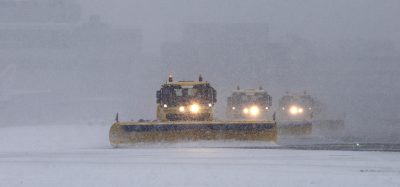Denver International Airport: The December blizzard of ’06, a catalyst for change
- Like
- Digg
- Del
- Tumblr
- VKontakte
- Buffer
- Love This
- Odnoklassniki
- Meneame
- Blogger
- Amazon
- Yahoo Mail
- Gmail
- AOL
- Newsvine
- HackerNews
- Evernote
- MySpace
- Mail.ru
- Viadeo
- Line
- Comments
- Yummly
- SMS
- Viber
- Telegram
- Subscribe
- Skype
- Facebook Messenger
- Kakao
- LiveJournal
- Yammer
- Edgar
- Fintel
- Mix
- Instapaper
- Copy Link
Posted: 31 July 2007 | Turner W. West Co-Manager, Denver International Airport | No comments yet
On December 20, 2006, Denver International Airport faced a snowstorm that challenged every single aspect of the operation. The storm, now commonly referred to as the December Blizzard of ‘06, brought over 20 inches of snow, with wind gusts above 40 mph and white-out conditions to the Denver area.
On December 20, 2006, Denver International Airport faced a snowstorm that challenged every single aspect of the operation. The storm, now commonly referred to as the December Blizzard of ‘06, brought over 20 inches of snow, with wind gusts above 40 mph and white-out conditions to the Denver area.
These conditions eventually caused DEN to close for 45 hours during the worst possible time of year, the pre-Christmas rush. The lengthy airport closure cost the hub carriers at Denver millions of dollars, stranded nearly 5,000 passengers at the airport – ruining holiday plans for many – and sent ripple effects through the airspace system that took several days to level out. Afterwards, DEN senior management, including the newly hired directors of Airport Operations and Airport Maintenance, John Kinney and Ruth Rodriguez, closely examined every aspect of the events before, during and after the storm to find areas that could be improved upon, as well as to identify future challenges. In the end, the December Blizzard has proven to be a catalyst for DEN to reinvent its winter operations program.
Systems approach
Winter Operations at Denver International Airport have always been thought of as a systems approach to maintaining the airport. As any airport operator in a snow belt knows, maintaining a safe and efficient operation during a winter storm involves much more than just ploughing runways. There are many pieces to the airport winter operations puzzle and missing just one can have a significant impact on the overall picture. Some other areas that require constant snow-removal attention include access roads, emergency response roads, parking lots, gate and ramp areas, and deicing pads. If any one of these elements were to be overlooked during a snowstorm, it could easily have an adverse impact on the safety or efficiency of the airport.
The systems approach to maintaining the airport during adverse conditions requires effective communication and collaboration. DEN has always employed timely notifications whenever the airport enters a Snow Alert or Snow Emergency status. When a significant snowstorm is forecast to occur (Snow Emergency: 6+” and/or 25+ mph winds), Airport Operations supplements the notifications with pre-storm tenant briefings. Follow-up briefings during the storm are typically done via a ring-down telephone system activated from the airport’s Incident Command Center. All of these methods were used during the December Blizzard.
Before the storm
On the Monday before the December Blizzard, Airport Operations declared a Snow Alert for DEN, to be effective on Tuesday, Dec. 19 at 6 a.m., based on an initial forecast from the National Weather Service (NWS) projecting 1-2 inches of snow Tuesday night into Wednesday. Notifications for the Snow Alert were completed in order to provide personnel to respond and be available to implement the plan. By Monday afternoon, the NWS projection had increased to 3-6 inches of snow. On Tuesday afternoon, as the NWS and other weather forecasting outlets began to show expected snow accumulations snowballing to as high as 18+ inches and winds of over 20 miles per hour, Airport Operations escalated the Snow Alert to a Snow Emergency. The Snow Emergency for DEN was declared on Tuesday, Dec. 19, to be effective at 6 a.m. on Wednesday, Dec. 20.
A pre-storm briefing was immediately held with internal and external stakeholders including, but not limited to, airport management, operations, maintenance, parking and ground transportation, security and terminal operations, Denver Police and Fire, Denver Paramedics, the airlines, deicing contractors, the Federal Aviation Administration and the Transportation Security Administration. During the briefing, operations and maintenance described their plans to keep the four north/south runways in play, with three runways operational, since strong northerly winds would likely prevent aircraft from using the two east/west runways. This method, though usually effective for maintaining the primary runways during heavy snowfall, automatically puts the airport into a flow program because there are times during a typical day when five of the airport’s six runways are needed to handle regular arrival or departure rates.
The FAA stressed its desire to keep the four north/south runways in play, with at least three of them open and available, especially during the morning arrival bank. The TSA discussed its plans for staffing the three security checkpoints and all 26 security lanes. Terminal Operations and Guest Services confirmed their readiness to activate the Stranded Passenger Plan. DEN’s Properties Office confirmed that staffing and supply issues had been discussed with all of the airport concessionaires. Denver Police, Fire, and Paramedics said they would be well-staffed for the storm.
The airlines were asked if they planned to reduce their schedules because of the weather forecasts. Frontier and United, the two largest carriers at DEN, both said they planned no initial schedule reductions because of the extremely heavy pre-holiday load factors. Wednesday and Thursday, Dec. 20 and 21, were forecast to be the busiest two days on record for DEN. Nearly 163,000 passengers were expected to pass through Denver International Airport each day, more than 30,000 more than the daily average of 130,000.
Following the pre-storm briefing on Dec. 19, Airport Operations developed and coordinated a snow-removal plan with the DEN Maintenance Division. The plan followed the general practice of maintaining all of the following airfield priorities: runways, taxiways, emergency response routes, deice pads, ramps and vehicle service roads. The Maintenance Division, which is responsible for maintaining and operating snow-removal equipment and providing adequate staffing to implement the snow-removal plan, prepared more than 100 pieces of snow-removal equipment for the airside, another 80 pieces for the landside and implemented 12-hour staffing schedules. Equipment and manpower were allocated to provide teams for the east and west airfields (runways and taxiways), a ramp and deice pad team and an emergency response road and vehicle service road team. Separate crews were readied for use on the landside roadways and in the parking lots.
The storm
As the storm descended on DEN on Wednesday morning, strong northerly winds prevented aircraft from using the two east/west runways, as had been predicted. Therefore, the airfield snow-removal teams focused on the four north/south runways. The east and west airfield snow teams alternated cleaning efforts between the parallel runways on each side of the airport, providing at least two open runways at all times. Strong winds and blowing snow, combined with a snowfall rate of 1-3 inches an hour, significantly reduced visibility and eventually forced DEN into low-visibility operational restrictions. As the reduced visibility slowed snow-removal operations and increased runway occupancy times, it became increasingly difficult to maintain safe runway conditions and braking action. Ultimately, the decision was made to consolidate the east airfield snow-removal team into the ramp and west airfield teams in an attempt to keep the ramps and west airfield runways open.
By early Wednesday afternoon, snow accumulations on the ramps increased to the point where several aircraft became stuck in the drifting snow banks. As a result, ramp snow crews were pulled away from their assignments to “rescue” the stranded aircraft. One snow plough even became stuck while trying to dig out an aircraft. As these “rescue operations” began to take longer and longer due to the blizzard conditions, the more than 19 million square-feet of ramp areas were becoming impassable. It became more and more apparent to Airport Operations managers that it was no longer possible to maintain a safe operating environment for aircraft and the recommendation was made to airport management to close the airport. Mother Nature was quite simply winning the battle.
The aftermath
The airport was closed at 2:37 p.m. on Wednesday, although the storm was far from over. Blizzard conditions overwhelmed the city and streets and highways were becoming nearly impassable. The Colorado State Patrol closed Interstate 70 from just south of DEN to the Colorado-Kansas border. These conditions, combined with the closure of the airport, left thousands of passengers stranded at DEN. The airport coordinated with the Denver Office of Emergency Management and the Mile High Chapter of the American Red Cross to provide water, blankets, cots and other comforts to as many passengers as possible. At one point during the storm, 20 buses were loaded with passengers and sent from the airport to area hotels, with DEN landside snow ploughs clearing the way. The airlines cancelled several hundred flights through the course of the storm as they waited to see when DEN would reopen. The numerous cancellations, coupled with the incredibly high holiday season load factors, meant that it would be several days before some travellers were able to get a flight out of Denver.
Snow-removal crews continued to work throughout the storm in an effort to expedite the reopening of the airport. That proved to be an incredibly daunting task given the strong winds, snow accumulations, and sheer size of the airfield. Sustained winds over 20 mph, with gusts over 35 mph, continued until late on the morning of Thursday, Dec. 21, drifting 20 to 22 inches of snow across the 55 million square feet of airside concrete. When all was said and done, DEN crews would move more than 4.4 million cubic yards of snow on the airport while clearing more than 1,261 lane miles of concrete, the equivalent of a highway from Denver to Detroit or San Francisco.
Before 2006, Denver International Airport had closed for significant amounts of time only twice because of snow: once in October 1997 for a 17-inch storm and again in March 2003 for a 29-inch storm. Though each of those storms was a major event for the airport, the timing of the December 2006 blizzard, just before the holiday travel season, focused a lot of attention on DEN’s winter operations program. Historically the program had been effective for the airport, but several years of fiscal conservatism, because of 9/11 and the uncertain nature of the United Airlines bankruptcy, had taken its toll. An unprecedented growth in passengers, aircraft operations and facility expansion had not been proportionally matched in terms of snow-removal equipment and manpower. The result of this was not clear until the December Blizzard, when the DEN snow-removal crews were simply beaten down by Mother Nature. The resulting spotlight of attention on the DEN snow-removal program has proven to be a significant catalyst for change.
Looking ahead
In the wake of the December Blizzard, airport management has begun a full review of the DEN snow-removal program. “The key to success in crafting a responsive and sustainable snow program for the airport is a collaborative approach, whereby input from all stakeholders is received for developing the snow plan, as well as planning for each individual snow event,” said Director of Operations, John Kinney. Therefore, the issues that surfaced during the 2006 winter season are being examined from several angles. Staffing levels, equipment types, crew schedules, and snow-removal priorities are all being reviewed. Airport Operations has spent the last several months benchmarking DEN’s snow plan with our peers at other large hub winter ops airports around the country. A consulting firm, Critical Path Inc. of Missoula, Montana, has been hired to provide a new perspective on the program.
Some of the changes that management have implemented to upgrade current processes include procuring two new runway friction testers and an internet collaborative communications system to improve the way DEN communicates with the airport community during irregular operations. The airport is also currently evaluating snow-melters and multi-function snow-removal equipment from some of the leading manufacturers in the industry. The airport has also issued an RFP for contracted snow removal on the ramp areas, something that has typically been done by airport crews. In short, none of the historical methods that have been used are sacred as the airport updates and upgrades to a winter operations program that will help to maintain Denver International’s status as a world-class airport.
As Denver International Airport continues to proceed down the path toward a new snow- removal program, one of the biggest challenges will be managing expectations. The airport community correctly believes that all of the effort and allocation of resources by the airport will result in a superior winter operations program that will increase efficiency and safety at DEN. But all stakeholders must be made aware what the capabilities of the new program are and when it will be fully ready. For example, there may be some unrealistic expectations: that DEN will be ready to deal with another significant snowstorm as early as next season, or that once the program is fully implemented, DEN will never close again due to snow. The reality is that programs take time to institute, snow-removal equipment takes time to procure, build and deliver and snow events can cause capacity constraints. The bottom line is that Mother Nature always wins. As this message is repeated over the coming months and years, while DEN upgrades its winter operations program, one theme will stay the same: the men and women at Denver International Airport will give their very best every single day, regardless of the weather, to provide their customers with an efficient world-class facility that never compromises on safety.
Turner W. West
Turner W. West became Co-Manager of Denver International Airport with Vicki F. Braunagel on July 21, 2003. Mr. West served as Deputy Manager of Aviation/Maintenance and Engineering from October 2000, after serving as Acting Deputy Manager of Aviation/Maintenance and Engineering since July 1999. Prior to being named as Acting Deputy Manager of Aviation/Maintenance and Engineering, Mr. West served as Deputy Manager of Aviation/Maintenance from September 1, 1985. Mr. West has 34 years of aviation industry experience, including 18 years of airline management experience. Prior to joining the City, he was with Frontier Airlines from 1979 to 1985, Texas International Airlines from 1978 to 1979, Otis Engineering Corp., a subsidiary of Halliburton Co., from 1975 to 1978, and Braniff International Airways from 1966 to 1975.

















